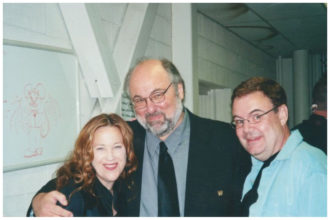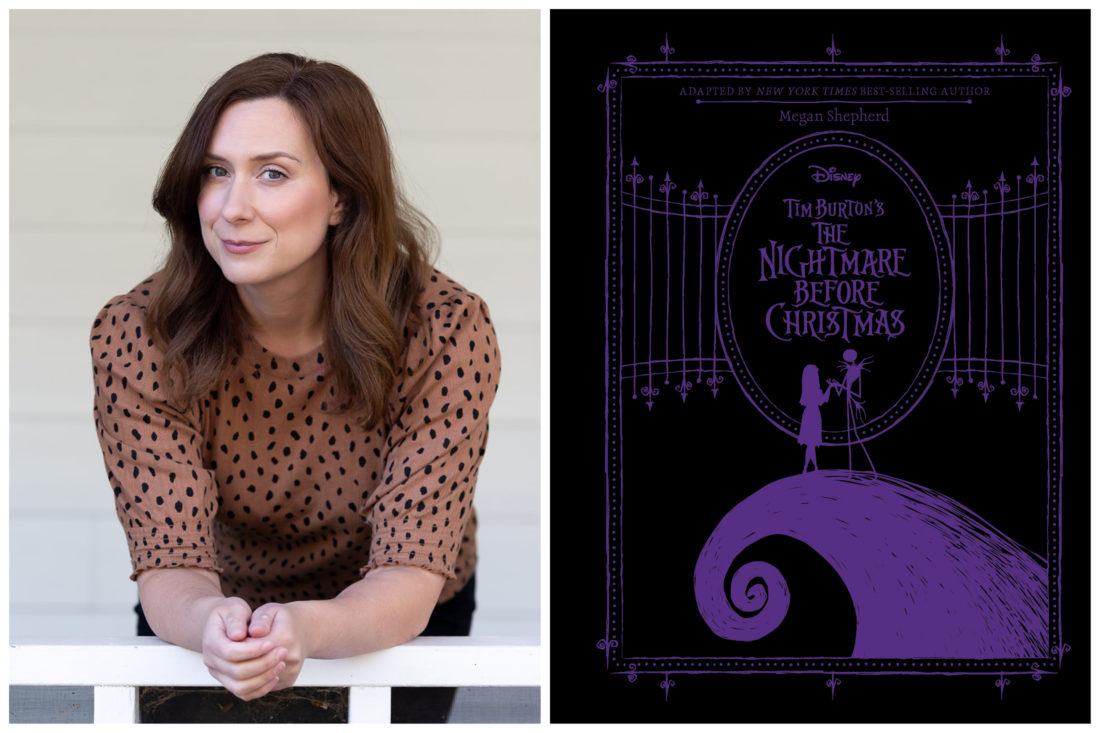Earlier this summer, Disney published local author Megan Shepherd‘s novelization of The Nightmare Before Christmas to celebrate the film’s 30-year anniversary. That Asheville has one writer with ties to Tim Burton‘s classic stop-motion animated musical is special enough. But longtime fans of the movie might recall fellow local author Frank Thompson‘s 1993 Tim Burton’s The Nightmare Before Christmas: The Film, The Art, The Vision — the official “making of” book that coincided with the movie’s release.
Xpress caught up with both Shepherd and Thompson to discuss their individual experiences in writing each book, as well as their shared appreciation for the film and why they think The Nightmare Before Christmas still resonates with audiences 30 years later.
Facing your fears
In both her young adult and adult novels, Shepherd says she is frequently drawn to tales of fantasy and the macabre. Whether writing stories inspired by H.G. Wells’ The Island of Doctor Moreau (which influenced her 2013 novel, The Madman’s Daughter) or that blend the supernatural with classic horror films (this year’s Midnight Showing), a dark playfulness serves as a through line across her catalog.
So, when Disney presented Shepherd the opportunity to write the tale of Halloweentown’s “pumpkin king” Jack Skellington and his misguided attempt to take over Santa Claus’ work in Christmastown, she was ready.
“A lot of my works are retellings of classics, so I was already familiar with researching and retooling beloved works,” she says. “Plus, I’m a lifelong fan of Disney and Tim Burton.”
Yet, a fear of stop-motion animation (which she admits sounds strange), kept Shepherd from seeing the film in theaters when it came out.
“However, a friend of mine loved it and had the soundtrack, which we listened to endlessly, and so I first fell in love with the film from its songs without ever seeing a single clip,” Shepherd says. “When I did finally see the movie (a few years later), it was like a lightbulb went off. Suddenly, all the voices fit with characters I didn’t know, and there were whole scenes and plot points I couldn’t have imagined. And, ironically, the stop motion actually enhanced the experience, since the film was supposed to be creepy.”
To prepare herself for the novelization, Shepherd rewatched the movie several times to reacquaint herself with the world of Jack, Sally and Oogie Boogie. She also visited multiple online fan groups to soak up what captivated the most die-hard viewers about the story.
Even with this firm foundation, she encountered challenges in conveying the film’s characters’ interiority, since most of these expressions occur via song. Unable to use the lyrics in the novel, Shepherd had to find other ways to express the characters’ emotional arcs beyond just the actions and words seen on screen.
“Disney wanted the text to adhere very closely to the film, so I hit it frame by frame, along with the original script, to capture every moment,” she says. “I like to think of it as The Nightmare Before Christmas bible: Fans will find every aspect that they love from the film faithfully captured in prose.”
Burton beckons
Thompson’s invitation into the Nightmare Before Christmas family came about after his 1991 book, Alamo Movies, caught the attention of Michael Singer, author of Batman Returns: The Official Movie Book, which chronicled Burton’s Caped Crusader sequel. Singer was subsequently hired as a publicist for filmmaker Oliver Stone and assigned to write several books related to Stone’s movies.
“One day, out of nowhere, the phone rang. It was Tim Burton,” Thompson says of the fateful 1992 call. “He said that he had wanted Michael to write the Nightmare book but because of Michael’s new situation, he couldn’t. But Michael had said to Burton, ‘I’ll tell you who would do a great job — Frank Thompson.’”
The assignment involved covering every aspect of the film’s production that was already underway in San Francisco, as well as conducting sit-down interviews with the film’s director, Henry Selick, Burton’s longtime producer Denise Di Novi and other key behind-the-scenes players.
“I didn’t have a great deal of information when I went to San Francisco. I had a cast and crew list and probably a synopsis of the film,” Thompson says. “My friend Howard Green, the legendary Disney publicist, accompanied me to Skellington Studios and always stayed two steps ahead of me, arranging the next interview while I was interviewing someone else.”

Thompson had conducted previous research on stop-motion animation for a separate project, offering him insights into the process. He recalls sitting for most of one day with Angie Glocka, who was animating the scene where an excited little boy runs downstairs on Christmas morning, opens a package and finds a shrunken head. Thompson was there for hours and swears that, at the end of the day, he could tell almost no difference between where the character had started and where he ended.
“That was a subject that I brought up with several of the animators — how do you get a ‘performance’ out of these figures when you have to move them so slowly and precisely, literally 24 times for every second of action?” he says. “Nobody could really answer me. They knew how to do it but not how to talk about it.”
Back in Los Angeles, Thompson conducted interviews with Burton, composer Danny Elfman and screenwriter Caroline Thompson, whom Frank says is no relation. And on Oct. 31, 1993, Thompson’s book was published, complete with plentiful behind-the-scenes photos and concept art sketches, as well as lyrics from Elfman’s songs.
Over the subsequent decades, Thompson remained connected to the film, hosting panel discussions at Disneyland and the El Capitan Theatre in Hollywood. Though he didn’t get to interview any of the voice actors during production, these events allowed him to meet Catherine O’Hara (who voices Sally), Glenn Shadix (the two-face Mayor) Ken Page (Oogie Boogie) and Paul Reubens (Lock, one of Oogie Boogie’s henchmen).
Halloweentown forever
Having witnessed The Nightmare Before Christmas’ appeal close-up for so long, Thompson isn’t surprised that it remains popular today.
“There’s nothing about the film that seems tied to any particular time. New generations can be introduced to it now, and it will affect them just as strongly as it affected original audiences,” he says. “The animation is brilliant, the songs are great, the voice actors are the cream of the crop — it’s just a wonderful film.”
After mining the hearts and minds of the film’s characters, Shepherd has a different take on what keeps bringing viewers back.
“Jack’s yearning for something more is a universal feeling. It’s one reason why the film feels so fresh and relevant even 30 years later,” Shepherd says. “We’re all searching for new worlds beyond ourselves — and we all want to return home changed for the better by what we’ve learned.”
As for the cosmic symmetry that has pulled both authors to call Asheville home, Thompson calls it “a nice coincidence” and Shepherd “a stroke of luck.” But on second thought, Shepherd wonders if additional forces may have been at work.
“After all,” she says, “Asheville is so rich in both literary history and ghostly legends that it draws all kinds of creatives with wild imaginations.”




Before you comment
The comments section is here to provide a platform for civil dialogue on the issues we face together as a local community. Xpress is committed to offering this platform for all voices, but when the tone of the discussion gets nasty or strays off topic, we believe many people choose not to participate. Xpress editors are determined to moderate comments to ensure a constructive interchange is maintained. All comments judged not to be in keeping with the spirit of civil discourse will be removed and repeat violators will be banned. See here for our terms of service. Thank you for being part of this effort to promote respectful discussion.